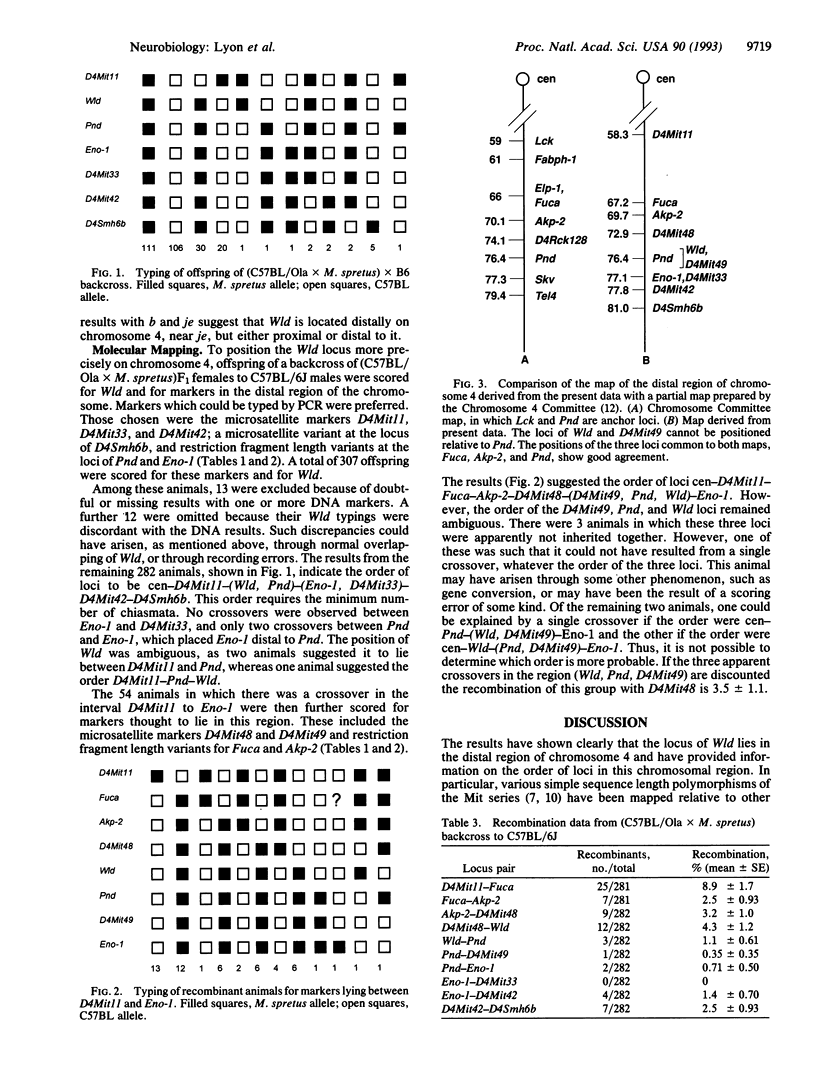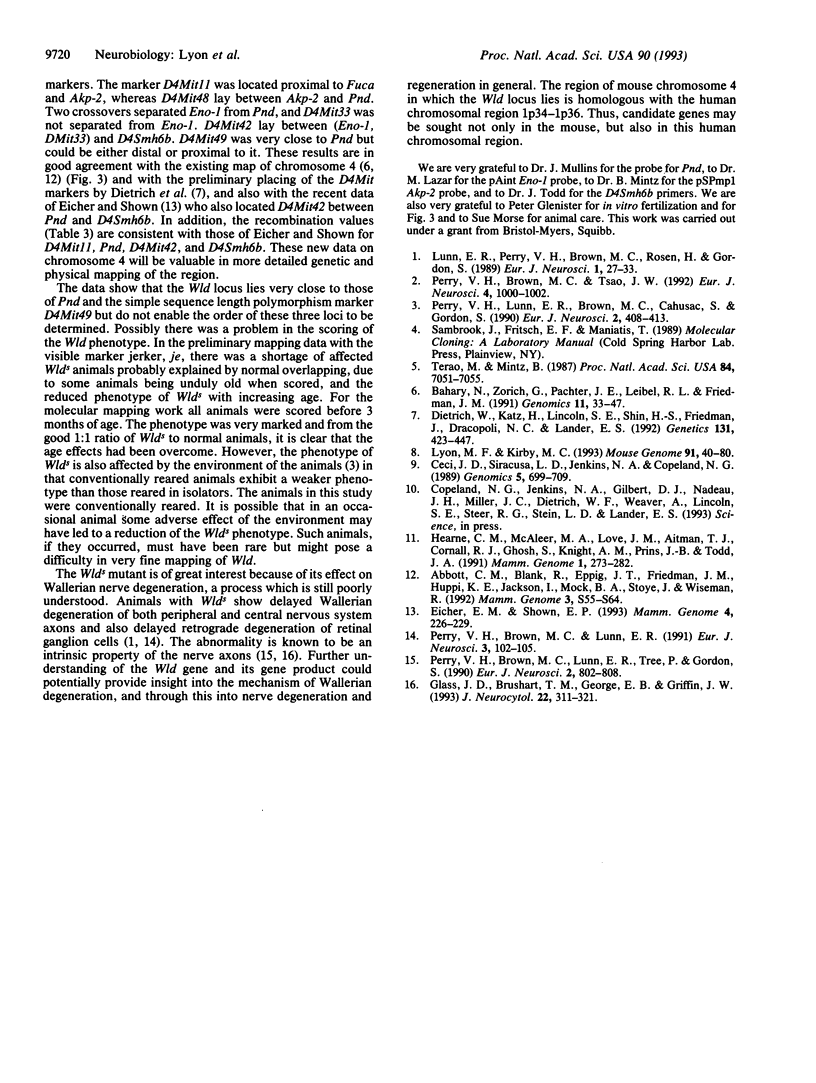Abstract
When a nerve axon is cut or crushed, the nerve fibers in the distal part of the axon, separated from the cell body, undergo a form of spontaneous degeneration, known as Wallerian degeneration. A substrain of the mouse inbred strain C57BL, known as C57BL/Ola, carries a mutant form of a gene involved in Wallerian degeneration in the peripheral and central nervous systems, and in retrograde degeneration of retinal ganglion cells. Wallerian degeneration in this substrain is abnormally slow. Previously the defect had been shown to be due to an autosomal dominant gene. The locus has been given the name and symbol Wallerian degeneration Wld, with the mutant allele Wlds (Wallerian degeneration-slow). The Wld locus has now been mapped, by using conventional and molecular markers, to the distal end of chromosome 4, near the locus of pronatriodilatin (Pnd). The order of loci (with recombination distances in centimorgans, cM) is cen-D4Mit11-8.9 +/- 1.7 cM-Fuca-2.5 +/- 0.93 cM-Akp-2-3.2 +/- 1.1 cM-D4Mit48-3.5 +/- 1.1 cM-(Wld, Pnd, D4Mit49)-0.71 +/- 0.50 cM-(Eno-1, D4Mit33)-1.4 +/- 0.70 cM-D4Mit42-2.5 +/- 0.93 cM-D4Smh6b. The information on the position of the Wld locus should be valuable in further characterization of this gene involved in nerve degeneration and regeneration.
Full text
PDF



Selected References
These references are in PubMed. This may not be the complete list of references from this article.
- Abbott C. M., Blank R., Eppig J. T., Friedman J. M., Huppi K. E., Jackson I., Mock B. A., Stoye J., Wiseman R. Mouse chromosome 4. Mamm Genome. 1992;3(Spec No):S55–S64. doi: 10.1007/BF00648422. [DOI] [PubMed] [Google Scholar]
- Bahary N., Zorich G., Pachter J. E., Leibel R. L., Friedman J. M. Molecular genetic linkage maps of mouse chromosomes 4 and 6. Genomics. 1991 Sep;11(1):33–47. doi: 10.1016/0888-7543(91)90099-z. [DOI] [PubMed] [Google Scholar]
- Ceci J. D., Siracusa L. D., Jenkins N. A., Copeland N. G. A molecular genetic linkage map of mouse chromosome 4 including the localization of several proto-oncogenes. Genomics. 1989 Nov;5(4):699–709. doi: 10.1016/0888-7543(89)90111-0. [DOI] [PubMed] [Google Scholar]
- Dietrich W., Katz H., Lincoln S. E., Shin H. S., Friedman J., Dracopoli N. C., Lander E. S. A genetic map of the mouse suitable for typing intraspecific crosses. Genetics. 1992 Jun;131(2):423–447. doi: 10.1093/genetics/131.2.423. [DOI] [PMC free article] [PubMed] [Google Scholar]
- Eicher E. M., Shown E. P. Molecular markers that define the distal ends of mouse autosomes 4, 13, and 19 and the sex chromosomes. Mamm Genome. 1993;4(4):226–229. doi: 10.1007/BF00417568. [DOI] [PubMed] [Google Scholar]
- Glass J. D., Brushart T. M., George E. B., Griffin J. W. Prolonged survival of transected nerve fibres in C57BL/Ola mice is an intrinsic characteristic of the axon. J Neurocytol. 1993 May;22(5):311–321. doi: 10.1007/BF01195555. [DOI] [PubMed] [Google Scholar]
- Hearne C. M., McAleer M. A., Love J. M., Aitman T. J., Cornall R. J., Ghosh S., Knight A. M., Prins J. B., Todd J. A. Additional microsatellite markers for mouse genome mapping. Mamm Genome. 1991;1(4):273–282. doi: 10.1007/BF00352339. [DOI] [PubMed] [Google Scholar]
- Lunn E. R., Perry V. H., Brown M. C., Rosen H., Gordon S. Absence of Wallerian Degeneration does not Hinder Regeneration in Peripheral Nerve. Eur J Neurosci. 1989;1(1):27–33. doi: 10.1111/j.1460-9568.1989.tb00771.x. [DOI] [PubMed] [Google Scholar]
- Perry V. H., Brown M. C., Lunn E. R., Tree P., Gordon S. Evidence that Very Slow Wallerian Degeneration in C57BL/Ola Mice is an Intrinsic Property of the Peripheral Nerve. Eur J Neurosci. 1990;2(9):802–808. doi: 10.1111/j.1460-9568.1990.tb00472.x. [DOI] [PubMed] [Google Scholar]
- Perry V. H., Brown M. C., Lunn E. R. Very Slow Retrograde and Wallerian Degeneration in the CNS of C57BL/Ola Mice. Eur J Neurosci. 1991;3(1):102–105. doi: 10.1111/j.1460-9568.1991.tb00815.x. [DOI] [PubMed] [Google Scholar]
- Perry V. H., Brown M. C., Tsao J. W. The Effectiveness of the Gene Which Slows the Rate of Wallerian Degeneration in C57BL/Ola Mice Declines With Age. Eur J Neurosci. 1992;4(10):1000–1002. doi: 10.1111/j.1460-9568.1992.tb00126.x. [DOI] [PubMed] [Google Scholar]
- Perry V. H., Lunn E. R., Brown M. C., Cahusac S., Gordon S. Evidence that the Rate of Wallerian Degeneration is Controlled by a Single Autosomal Dominant Gene. Eur J Neurosci. 1990;2(5):408–413. doi: 10.1111/j.1460-9568.1990.tb00433.x. [DOI] [PubMed] [Google Scholar]
- Terao M., Mintz B. Cloning and characterization of a cDNA coding for mouse placental alkaline phosphatase. Proc Natl Acad Sci U S A. 1987 Oct;84(20):7051–7055. doi: 10.1073/pnas.84.20.7051. [DOI] [PMC free article] [PubMed] [Google Scholar]


